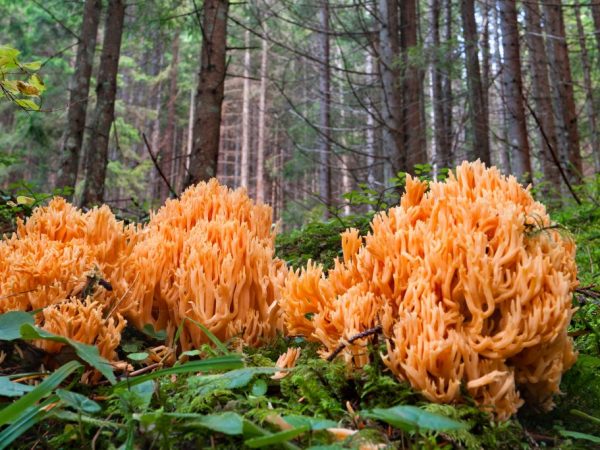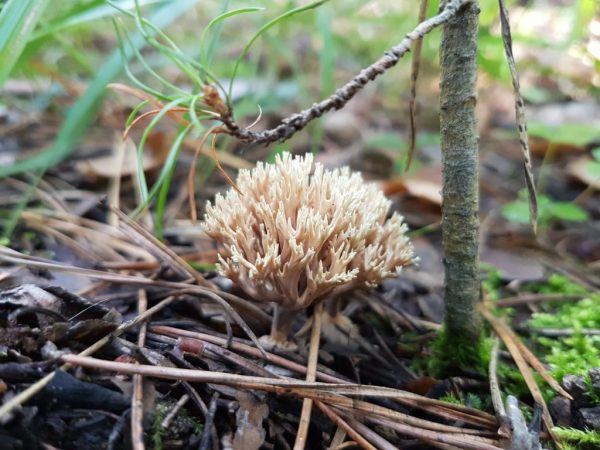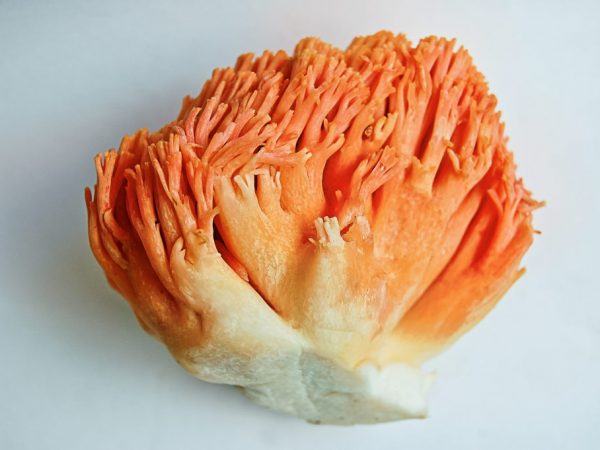Features of the slingshot mushroom
The mushroom kingdom is distinguished by a great variety of representatives. They have different properties and appearance, sometimes quite bizarre. These include the horned mushroom, which, due to its unusual appearance, is popularly called "deer horns".

Features of the slingshot mushroom
Description
In science, this one is called Hericium coralloides (Horny or Ramaria). It belongs to the 4th category of edibility. According to the structural features of the mycelium, these fungi are classified as higher, that is, they have cellular mycelium. These are basidiomecetes, which are popularly called hedgehogs, forest corals, deer horns or horns.
Horned mushrooms have the following signs of external structure:
- in shape, fruiting bodies are erect, rod-shaped, branched;
- the color is often white, gray, yellow or cream;
- the diameter of the fruiting body - from 16 to 30 cm;
- height - up to 25 mm;
- bitter taste;
- the aroma is unpleasant, pungent;
- weight - up to 1 kg.
The surface color changes with the age of the fungus. For example, the reed horn of the age becomes amethyst or orange.
Beautiful and unusual to the eye, horned mushrooms are listed in the Red Book of Russia. They inhabit shaded thickets on decayed foliage or rotten fallen tree trunks. The ramaria mushroom loves wet places, the period of its active growth is from mid-summer to the end of October.
The reed stingray does not infect worms, the only pest for this species is the wireworm.
It is easy to grow such "corals" at home using the usual technology used for growing mushrooms.
Views
These organisms are divided into edible and inedible. There are no horns dangerous to human life and health. For a mushroom picker, edible horned mushrooms are a real find if you know how to cook them correctly. These mushrooms are relatives of chanterelles.
Edible species include:
- R. golden;
- R. amethyst;
- R. aciniform;
- R. yellow;
- R. truncated;
- R. reed.
Inedible species:
- R. fusiform;
- R. comb;
- R. pale yellow;
- R. purple;
- R. pistillate;
- R. fistful;
- R. straight.
Edible baby horned mushrooms are pleasantly scented mushrooms that are easy to cook. Most often they give a large harvest from one "bush".
Reed horn

Horned animals begin to collect at the end of summer.
The reed horn (Clavariadelphus ligula) is an edible species with a pale yellow tinge in the color of the fruit body. It belongs to saprophytes of the 4th category of edibility.
Its branches are in the form of a cylinder, thin, widened at the bottom. The appearance resembles a human language, as if sticking out of the ground, hence the name. The reed horned grows in coniferous forests in whole groups in the form of circles, which the foresters call "witch".
Their size is small, in height - up to 10 cm.The collection begins at the end of summer.
Ramaria ordinary
"Forest corals" - this is also called ramaria, which grows in pine forests. Its "stem" is incredibly beautiful and looks like a real branchy sea coral that accidentally got into the thicket.The appearance of ramaria is characterized by:
- dichotomous "trunk";
- white color of the inner layer;
- hymenial surface (forming and therefore bearing spores);
- yellow.
Irina Selyutina (Biologist):
The ramarias are characterized by the so-called. dichotomous branching of the components of the fruiting body. With this type of branching, the main axis is divided in half at its top, and each part of it continues to grow until a certain moment and also begins to branch in a similar way. Therefore, a kind of "forks" or, as they say, V or U branches appear. The dichotomous type of branching is considered the most primitive and, accordingly, the most ancient from the point of view of biology.
With age, ramaria changes color to orange-red. It is believed that chanterelles and horned ones have common ancestors, therefore, in structure, they have a certain similarity.
Ramaria prefers to grow on litter in coniferous forests. It can be eaten, but it has a bitter taste, so it should be harvested at the end of August and September, since young ramaria tastes less bitter.
Beautiful horned
It is an inedible mushroom that grows in deciduous and mixed forests. It is characterized by:
- height - 20 cm;
- diameter - 18-20 cm;
- short, thick and dense leg;
- bright pink color in young organisms.
Old ramaria become whitish, strongly branching at the bottom, the tips of the "branches" first turn yellow, and then brown or brown.
Eating can lead to slight disruption of the gastrointestinal tract due to the characteristic bitter taste.
Crested hornbeam
An inedible forest organism that bears fruit in conifers, deciduous and mixed forests from the second half of July to the end of October. Grows in groups resembling bushes. It has a comb-like shape and a cream or white body color, at the base of which there is a thick, dense leg.
The pulp has a characteristic bitterness. She is fragile and delicate, without a bright aroma.
Application

Mushrooms are used for medicinal purposes
"Deer horns" have a lot of useful properties due to their chemical composition.
Application in medicine
From their micellar structure, they learned to isolate specific polysaccharides that have the property of stopping the development of Ehrlich's carcinoma. It has been scientifically proven that the extract from the barnacles successfully fights sarcoma.
Irina Selyutina (Biologist):
Tryptophan is an amino acid that is part of the proteins of almost all living organisms on our planet. Tryptophan belongs to the so-called group. essential acids. Together with vitamin B6 (adermin) and magnesium, tryptophan takes part in the synthesis of the hormone of happiness - serotonin. It is the lack of it in people during a diet that causes the desire to gorge on "junk food" and provokes depression.
The tryptophan located in the cells of the pulp of the fungus (and other organisms containing it) is called the precursor, or the precursor of serotonin, from which melatonin and niacin can then be synthesized.
These organisms contain natural antibiotics and contain the precursor of serotonin (tryptophan) and its metabolite, 5-hydroxytryptophan. For medicinal alcoholic tinctures, the horned heads are harvested young until the fruiting bodies have acquired a dark brown hue.
In folk medicine, hedgehogs are used to treat joints, recover from fractures and to get rid of worms.
Cooking applications
Soups, in those regions where the horns are harvested, are usually prepared with the addition of a yellow slingshot, but the reed slingshot is more used for pies or caviar. "Forest corals" are also used to prepare delicious snacks and pie fillings. Horns - reed or yellow, great for frying in batter.
For preparations for the winter, drying or freezing, they are pre-soaked well and thoroughly washed several times so that all the bitterness comes out and only a pleasant aroma remains.
Harm and contraindications
Only familiar mushrooms should be collected, it is necessary to carefully sort out the harvested crop in order to exclude the ingress of poisonous specimens. Otherwise, severe poisoning occurs.
These unique and beautiful "horns" absorb all the toxins from the environment, so there is no need to collect them near roads or factories. Even edible species in this case can have a negative effect on the digestive tract and the human body as a whole.
It is better for pregnant women to consult a gynecologist before consuming such a forest delicacy. For children under 14 years old, it is possible to introduce it into the diet only after consulting a pediatrician.
Conclusion
Forest "deer horns", reed horns and other species are pleasant and easy to collect, because they practically have no poisonous analogues in the mushroom world. Found even a single family is able to feed the whole company. The species of these interesting mushrooms are used in folk medicine as a natural antibiotic.



